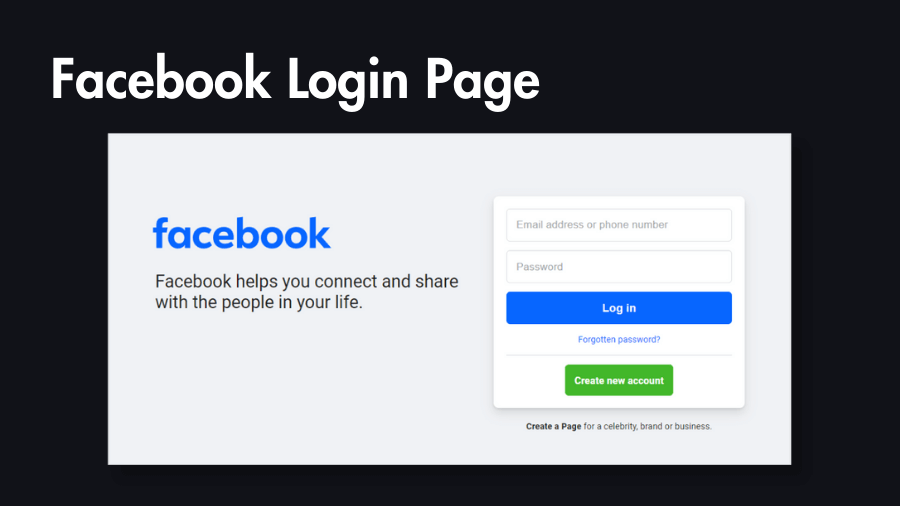Creating a Facebook-inspired login page using HTML and CSS is a great way to practice front-end web development skills. In this tutorial, you will learn how to create exactly and responsive Facebook login page UI using just HTML & CSS from scratch.
Build Facebook Login Page Using HTML And CSS
Prerequisites to build this Facebook Login Page UI
- Basic knowledge of HTML and CSS.
- A text editor (e.g., Visual Studio Code, Sublime Text).
- Web browser for testing.
Step 1: Write Basic HTML Structure for the FB Login Page
Open your text editor and create a new HTML file (e.g., index.html). Begin by setting up the basic structure of your HTML document.
<!DOCTYPE html>
<html lang="en">
<head>
<meta charset="UTF-8">
<meta name="viewport" content="width=device-width, initial-scale=1.0">
<title>Facebook Login Page</title>
<link rel="stylesheet" href="./styles.css">
</head>
<body>
<!-- Your content will go here -->
</body>
</html>Step 2: Add HTML Code for the Facebook Login Form to the Structure
Inside the <body> tag, let’s start building the login form. Include input fields for email/phone and password, along with the login button.
<div class="container">
<div class="wrapper">
<div class="brand">
<div class="logo">
<img
class="img"
src="https://static.xx.fbcdn.net/rsrc.php/y1/r/4lCu2zih0ca.svg"
alt="Facebook"
/>
</div>
<h2 class="heading">
Facebook helps you connect and share with the people in
your life.
</h2>
</div>
<div class="user-action">
<div class="form-container">
<form>
<div class="form-wrapper">
<input
type="email"
class="inputtext"
placeholder="Email address or phone number"
autofocus="1"
/>
<input
type="password"
class="inputtext"
placeholder="Password"
/>
<button type="submit">Log in</button>
<div class="forgot-password">
<a href="#">Forgotten password?</a>
</div>
</div>
<div class="create-account">
<a href="#">Create new account</a>
</div>
</form>
</div>
<div class="create-page">
<a href="#">Create a Page</a>
for a celebrity, brand or business.
</div>
</div>
</div>
</div>Step 3: Style the FB Login Page with CSS
Create a new CSS file (e.g., styles.css) to add styles to your login page.
@import url("https://fonts.googleapis.com/css2?family=Roboto:wght@400;700&display=swap");
* {
box-sizing: border-box;
}
body {
font-family: "Roboto", sans-serif;
background: #f0f2f5;
color: #1c1e21;
}
input,
button,
a {
outline: none;
}
a {
text-decoration: none;
}
a:hover {
text-decoration: underline;
}
.container {
padding-top: 72px;
}
.container .wrapper {
display: flex;
gap: 20px;
padding: 20px;
overflow: hidden;
max-width: 980px;
margin: 0 auto;
}
.brand .logo {
display: block;
direction: ltr;
}
.logo img {
max-width: 350px;
margin-left: -36px;
}
.heading {
font-weight: 400;
font-size: 28px;
margin: 0;
}
.form-container {
background-color: white;
border-radius: 8px;
box-shadow: 0 2px 4px rgba(0, 0, 0, 0.1), 0 8px 16px rgba(0, 0, 0, 0.1);
padding: 20px;
min-width: 400px;
}
.form-wrapper {
display: flex;
flex-direction: column;
gap: 14px;
}
.inputtext {
background: #ffffff
url(https://static.xx.fbcdn.net/rsrc.php/v3/yU/r/O7nelmd9XSI.png)
repeat-x;
border: 1px solid #dddfe2;
padding: 15px;
border-radius: 6px;
font-size: 17px;
color: #1d2129;
}
.inputtext::-moz-placeholder {
color: rgb(164, 167, 171);
}
.inputtext::placeholder {
color: rgb(164, 167, 171);
}
.inputtext:focus {
box-shadow: 0 0 0 2px #e7f3ff;
border-color: #0866ff;
caret-color: #0866ff;
}
button[type="submit"] {
background: #0866ff;
color: white;
border-radius: 6px;
border: 0;
padding: 15px;
font-size: 18px;
font-weight: 700;
cursor: pointer;
}
button[type="submit"]:hover {
opacity: 0.9;
}
.forgot-password {
text-align: center;
border-bottom: 1px solid #dadde1;
padding-bottom: 15px;
}
.forgot-password a {
color: #0866ff;
font-size: 14px;
}
.create-account {
text-align: center;
padding-top: 15px;
}
.create-account a {
display: inline-block;
background: #42b72a;
color: #ffffff;
font-weight: 700;
padding: 15px;
border-radius: 6px;
text-decoration: none !important;
}
.create-account a:hover {
background: #00a400;
}
.create-page {
padding: 20px;
text-align: center;
font-size: 14px;
}
.create-page a {
color: #1c1e21;
font-weight: 700;
}
@media only screen and (max-width: 900px) {
.container {
padding: 0;
}
.container .wrapper {
flex-direction: column;
max-width: 400px;
}
.form-container {
min-width: unset;
}
.brand {
display: flex;
flex-direction: column;
align-items: center;
}
.brand img {
width: unset;
margin: unset;
margin-top: -20px;
}
.brand .heading {
font-size: 24px;
text-align: center;
}
}Step 4: View Your Facebook Login Page in a Browser
Save both files in the same directory and open the index.html file in a web browser. You should see a basic Facebook login page.
Congratulations! You’ve successfully built a Facebook login page using HTML and CSS. This tutorial provides a foundation that you can expand upon by adding more features and enhancing the visual design. Keep exploring and refining your web development skills. Happy coding!
